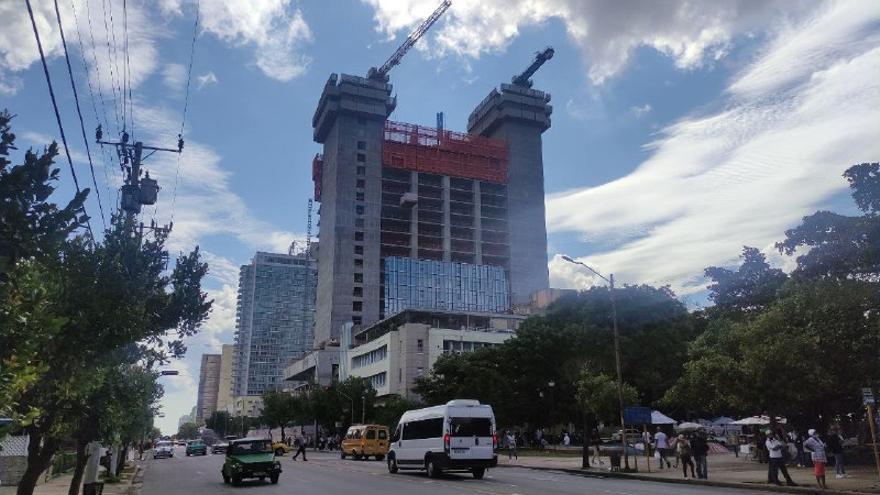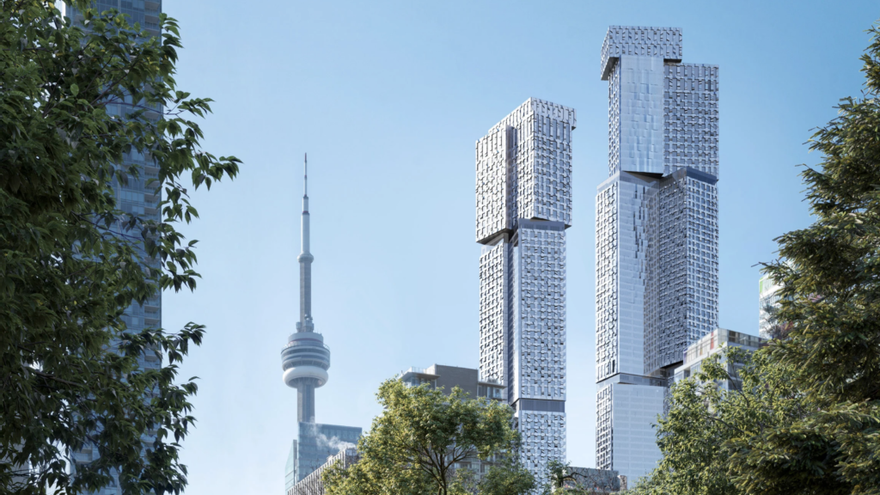
![]() 14ymedio, Madrid, July 20, 2022 — A building under construction at K and 23rd streets, which promises to be the tallest in Havana, has become the target of criticism by design professionals. The latest to take aim at “Tower K,” popularly known as “Lopez-Calleja Tower,” is Edelberto Diaz Aguilera, a Panama-based Cuban architect. The project is being developed by Gaesa, a hospitality conglomerate operated by the Cuban military under the leadership, until his recent death, of Luis Alberto Rodriguez Lopez-Calleja, Raul Castro’s former son-in-law.
14ymedio, Madrid, July 20, 2022 — A building under construction at K and 23rd streets, which promises to be the tallest in Havana, has become the target of criticism by design professionals. The latest to take aim at “Tower K,” popularly known as “Lopez-Calleja Tower,” is Edelberto Diaz Aguilera, a Panama-based Cuban architect. The project is being developed by Gaesa, a hospitality conglomerate operated by the Cuban military under the leadership, until his recent death, of Luis Alberto Rodriguez Lopez-Calleja, Raul Castro’s former son-in-law.
In an extensive article entitled “Vertigo-Inducing Follies” Diaz Aguilera unpacks what he sees as “mistakes” in the building, which bears some resemblance to Forma Towers, a Toronto highrise development designed by famed architect Frank Gehry.
Diaz Aguilera begins his critique by noting that it does address “the issue of lavish investments in the Cuban hotel sector” which ignore “the growing needs of the people,” a reference to another critique posted a month ago by fellow architect Rafael Muñoz. That piece caused such a stir that the government-controlled press felt compelled to defend the project.
In his post Muñoz expressed concerns about surface irregularities in the building’s recently poured concrete and safety measures to protect workers and pedestrians at this iconic El Vedado site, a stone’s throw from La Rampa, the Habana Libre hotel and the Coppelia ice cream parlor.
“It seems his warnings were not well received and, surprisingly, were interpreted as an act of dissent, which these days is a mortal sin on the Island,” says Diaz Aguilera about the official response to Muñoz’s post. “Let’s hope that, after guests on the hotel’s upper floors get their bill, they don’t ask for binoculars to see Key West considering how much money the island’s officials sank into this project.” Diaz Aguilera’s sardonic comment echoes an anecdote about Spain’s King Carlos III. When told how much it cost to build Havana’s 18th-century La Cabaña fortress, the king was reported to have said, “At that price, we should be be able to see Asturias.”

The ironic quip obliquely makes an important point: the future hotel is facing the wrong direction. Unlike the neighboring Habana Libre, it will not provide views to the north, “the best orientation for the bedrooms” if the goal is to avoid exposure to “the Caribbean sun and the huge amount of energy and money that will be needed to cool them.”
Similarly, Diaz Aguilera takes issue with the choice of insulated glass for the facade. Unless the material is non-reflective, he observes, it “will dazzle the eyes of drivers and pedestrians alike, which might be an intentional effort to produce the glare that one might expect from such a pretentiously gigantic and vainglorious project.”
He also notes that name of the building’s designer remains unknown. “We do not know if [the architect] is domestic or foreign. What is clear is that the architectural strategies employed in the city’s other tall buildings, such as overhangs to shield interiors from direct sunlight, have been ignored.” The approach adopted at Tower K, he says, is more typical of Toronto, “where the sun’s rays are allowed to enter a building to help heat the interior.”
He predicts this “tropical monster” will require powerful cooling systems, which will undoubtedly require large amounts of electricity, “all very sustainable but very much something our professors taught us not to do.”
Even more intrepid and cynical, Diaz Aguilera says, is the decision “to import curtain walls, powerful air conditioning systems and cutting-edge materials at a time when, as government rhetoric repeatedly maintains, the island is suffering under ’a cruel blockade,’ further increasing costs.” It amounts, he argues, to a questionable bet on an industry which has not seen occupancy rates rise above 30% for the last five years.
The architect also raises the issue of the building’s foundations. The cavernous rock on which the structure will sit caused problems during the construction of the Havana Hilton (now the Havana Libre) in the 1950s. “What considerations did they give to the foundations of the tallest building in Havana?. . . How do these costs compare to those of conventional construction?” Diaz Aguilera asks rhetorically.
After observations on the project’s all too predictable cost overruns and a critique that the project represents an attack on “the urban fabric of a city that should be preserved,” the architect concludes, “Regardless of where the money for this tower might have come from, whoever might have championed it, whatever political faction might have approved it and whatever reasons might be used to justify it, it does not have, nor will it ever have, my personal approval.”
____________
COLLABORATE WITH OUR WORK: The 14ymedio team is committed to practicing serious journalism that reflects Cuba’s reality in all its depth. Thank you for joining us on this long journey. We invite you to continue supporting us by becoming a member of 14ymedio now. Together we can continue transforming journalism in Cuba.
